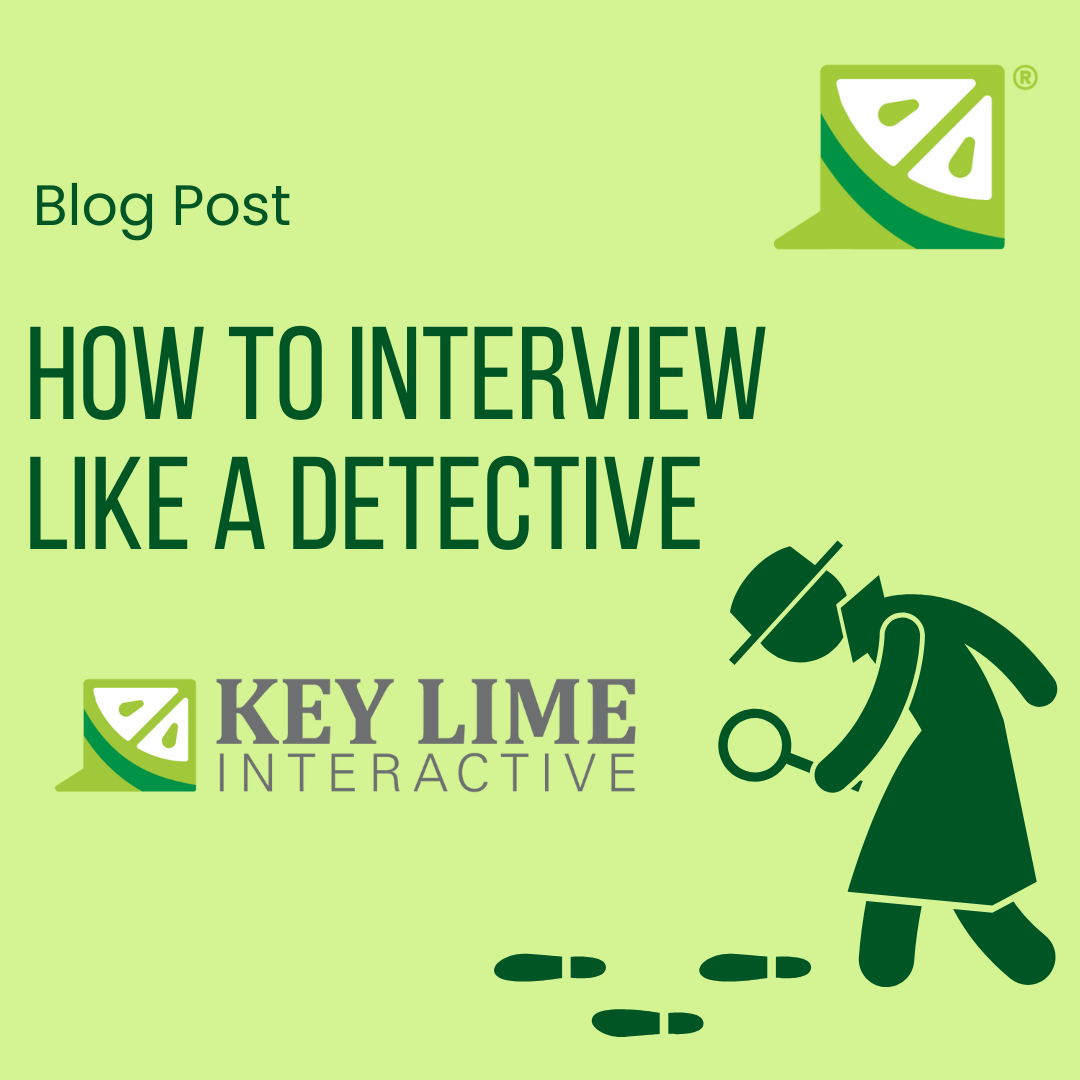
Prior to working as a UX researcher, I was a police officer for a major metropolitan department for almost 15 years. For a large part of that time, I was a detective. In this series, I’m going to talk about some very common interview techniques that detectives use that can help you get great insights as a UX researcher. This first part will focus mostly on preparation and mindset, with Part 2 to follow with interview techniques, strategies, and tips.
We’ve all seen how police interviews work on TV. A detective sits across the table from a suspect. The room is poorly lit, dingy, in disrepair. The only light in the room is in the suspect’s eyes. Our hero detective might get mad and shout. Or maybe they’ll play good cop or bad cop with their partner. Just like real life, right? Not so much …
A quick note, though. It’s important to understand the difference between an interview and an interrogation. Depending on who you ask, there are lots of ways to distinguish between the two. An easy way to differentiate is to interview witnesses and victims and interrogate suspects. Depending on how these encounters go and what evidence you uncover, an interview can become an interrogation and vice versa. In both cases, you’re looking to uncover facts and circumstances around the incident, but in an interrogation, you’re additionally looking for confessions or guilt-affirming statements.
Consider your environment
As a detective, the first thing I thought about was where the interview would take place. In a perfect world, all interviews would take place in the interview room at the police station. They are wired for video and sound, so everything gets captured, and I can control interruptions and distractions.
Practically, though, that doesn’t always work. Perhaps a witness doesn’t want to come down to the police station, or maybe they’ll feel intimidated and would be more comfortable in their own living room.
While 20 or 30 years ago, detective interviews may have happened, as I described in the first paragraph, they don't – or shouldn’t – anymore. Just like in a good UX interview, the room should be well-lit and inviting. The table should be pushed against the wall with the chairs on one side. You should be sitting on the same side of the table, facing your interviewee. This creates the mental impression that you are on the same side. Obstacles between you (like a table) can serve as subconscious mental barriers to openness.
Consider your creature comforts as well. Keep the temperature at a comfortable level, or warn your participants ahead of time if the room will be unusually warm or cold. Have water and a restroom available. Let them know they are free to stop or take breaks. The last thing you want is someone rushing through answers because they have to use the bathroom!
When doing online interviews, remember the basics. Have a good connection, position yourself in a quiet environment, and control interruptions. And finally, my personal pet peeve: test your background! There is nothing more distracting than a background that fades in and out or makes you appear and disappear. Test with a coworker to make sure it works well. You may need to reposition yourself or use the blurred background instead.
Think about how you present yourself.
As a detective, I dressed for the tasks of the day. If I had court that day, I would wear a suit and tie. If I was going to be doing some work on the street, I might wear blue jeans. Interviews can be a little tricky.
Depending on who you are talking to, they may respond differently to how you present yourself. Sometimes, we needed someone to be in a uniform to assert a little more authority. Other times, someone might be more comfortable and open if they don’t see a badge on their face. You need to feel the person you’re interviewing as best you can.
How does this play into UX? For me, one of the biggest factors I consider is who I am interviewing. Look at your recruitment cohort. Are you recruiting CEOs? College students? The way you present yourself to different groups will elicit different responses. This will obviously take some generalization and guesswork on your part, and you may not always get it right.
If I am interviewing an early 20-something college student, I might present myself more casually. A suit and tie in this circumstance could draw an undesirable response from the participant. Perhaps they will see me dressed so formally that they will subconsciously implement a power dynamic (especially if the interviewer is much older than the interviewee). They may be less likely to be disagreeable or say something they think I wouldn’t like to hear. Perhaps they will see me as uptight or stuffy and simply not be as comfortable with me.
What if I wore a T-shirt while interviewing a CEO of a Fortune 500 company? How might that person see that? They may see me as someone who isn’t taking myself, the interview, or their time seriously.
Consider your power dynamic.
UX researchers, just like detectives, hold the power in the interviews. We control when it starts and stops, what we talk about, and where we talk about it. Because you are the one running the show, asking the questions, the participant is naturally going to expect you to take the lead. Some people may impart a power dynamic to the conversation. They’ll be less likely to disagree with you, correct you, or say something they think you will not like.
I have found the best way to address this is head-on. Tell the participant that while you have certain things you need to cover, ultimately, you want their experiences and thoughts. You may be directing, but they are the stars. Further, you should specifically call out that you have no “skin in the game.” If concept testing, let them know you didn’t participate in the design, and anything negative they say won’t hurt your feelings. Reiterate that you want their thoughts, conclusions, and experiences, regardless of if they are negative or positive.
Set Expectations
Detectives on TV always love the “gotcha moment.” That moment where the suspect has been fooled. They realize they are caught and give a full confession. The simple truth is a confession almost never happens like that. Instead, when I was a detective, I would explicitly outline what I wanted to talk about. I would tell the person at the start, “I want to talk about what happened, what you did or didn’t see or do, and why.” By providing your agenda at the start, you’re lowering a person’s guard, making them more comfortable.
Think about it from the participant’s perspective in UX Research. You’ve taken a screener, which was likely intentionally designed to gather the data the researcher needed but also to mask who is conducting the research and what it is specifically about. You’re going to arrive (or login) for an interview, not knowing who you’ll talk to and perhaps with only a vague idea of what you’ll be talking about. You have no idea if your interviewer is going to be someone like you (age/gender/ethnicity) or not. If it’s an in-person interview, you don’t know the environment or where the bathrooms are. All you know is you’re going to be talking to a complete stranger who is going to be asking you questions for an hour (or whatever time frame you’ve been told).
That’s a little intimidating, isn’t it? Still, having trouble getting into that mindset? Think about your last job interview. You likely knew you’d be talking about your skills and position, but you didn’t know the questions they would be asking. You may not even know who specifically you’ll be interviewed by (or perhaps you’ll just have a name). Participants in research interviews will often have similar levels of anxiety (especially if it’s the first one they’ve ever done). Address it, call it out. Let them know exactly what to expect, and then do not surprise them.
Age, gender, ethnicity, and sexuality
I would like to think that I could conduct an interview with anyone about any topic. The fact is, I probably can, but it likely would not gather the best data. As a detective, this happened a lot. A woman who is the victim of domestic abuse or a sex crime might not feel as open with me as she would a female detective. A victim of a hate crime might feel more comfortable talking to a detective or officer from their peer group.
You need to consider your topic and recruiting segment when choosing who will conduct interviews. If you are recruiting primarily participants who are 18-22, how might they differ in their responses to a younger researcher versus a more senior researcher? They will likely view someone their own age differently. They may be less likely to feel or experience a power difference and more likely to think that someone their age will “get” what they are saying. Someone who is older, they might think, won’t get it. As we talked about before, a big age difference could also impart a power dynamic. An older researcher might remind them of a parent, grandparent, or even a teacher. They may subconsciously be more agreeable and less likely to say something contradictory or negative.
All of what we talked about today, I would consider “prep” work. In part 2, I’ll talk more about the specifics of conducting the actual interview, including specific interview methods, tips or tricks.
When thinking about interviews, there are plenty of right ways to do them, and at Key Lime Interactive, we have researchers from a plethora of backgrounds. Each researcher has a variety of interview skills they can bring to the table. Contact us, and we’ll see who the best researcher is for your project.









Comments
Add Comment